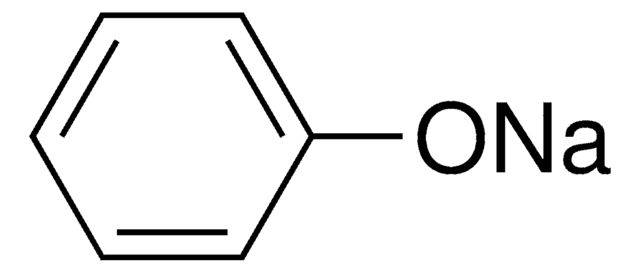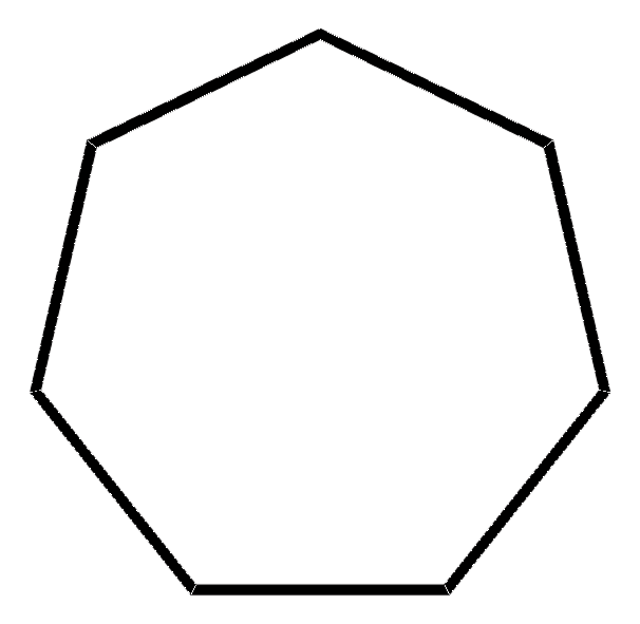125482
cis-Cyclooctene
contains 100-200 ppm Irganox 1076 FD as antioxidant, 95%
Synonym(s):
(Z)-Cyclooctene
Sign Into View Organizational & Contract Pricing
All Photos(1)
About This Item
Empirical Formula (Hill Notation):
C8H14
CAS Number:
Molecular Weight:
110.20
EC Number:
MDL number:
UNSPSC Code:
12352100
PubChem Substance ID:
NACRES:
NA.22
Recommended Products
Quality Level
assay
95%
form
liquid
contains
100-200 ppm Irganox 1076 FD as antioxidant
refractive index
n20/D 1.469 (lit.)
bp
145-146 °C (lit.)
mp
−16 °C (lit.)
solubility
H2O: insoluble
density
0.846 g/mL at 25 °C (lit.)
SMILES string
C1CCCC=CCC1
InChI
1S/C8H14/c1-2-4-6-8-7-5-3-1/h1-2H,3-8H2/b2-1-
InChI key
URYYVOIYTNXXBN-UPHRSURJSA-N
General description
cis-Cyclooctene undergoes addition reaction with carbon tetrachloride catalyzed by dichlorotris(triphenylphosphine) ruthenium(II) to yield 1-chloro-4-(trichloromethyl) cyclooctane (1,4-adduct). It undergoes epoxidation catalyzed by molybdenum oxide nanoparticles incorporated in a mesoporous silica shell coated on dense silica-coated magnetite nanoparticles.
Application
cis-Cyclooctene has been used to study the alkenes chemisorbed on silicon(100) by scanning tunneling microscopy.
Other Notes
Contains cyclooctane
Certificates of Analysis (COA)
Search for Certificates of Analysis (COA) by entering the products Lot/Batch Number. Lot and Batch Numbers can be found on a product’s label following the words ‘Lot’ or ‘Batch’.
Already Own This Product?
Find documentation for the products that you have recently purchased in the Document Library.
Customers Also Viewed
Radical reactions in the coordination sphere. 4. Addition of carbon tetrachloride to cis-cyclooctene catalyzed by dichlorotris (triphenylphosphine) ruthenium (II).
Matsumoto H, et al.
The Journal of Organic Chemistry, 43(9), 1734-1736 (1978)
A magnetically recyclable nanocomposite catalyst for olefin epoxidation.
Mohammadreza Shokouhimehr et al.
Angewandte Chemie (International ed. in English), 46(37), 7039-7043 (2007-08-10)
Voltage-dependent STM images of covalently bound molecules on Si (100).
Padowitz DF and Hamers RJ.
The Journal of Physical Chemistry B, 102(43), 8541-8545 (1998)
Xiao-Song Xue et al.
Chemical reviews, 117(13), 8622-8648 (2017-03-11)
The most fundamental concepts in chemistry are structure, energetics, reactivity and their inter-relationships, which are indispensable for promoting chemistry into a rational science. In this regard, bond energy, the intrinsic determinant directly related to structure and reactivity, should be most
Anyang Peng et al.
Science advances, 6(5), eaax6637-eaax6637 (2020-02-18)
Traditionally, a catalyst functions by direct interaction with reactants. In a new noncontact catalytic system (NCCS), an intermediate produced by one catalytic reaction serves as an intermediary to enable an independent reaction to proceed. An example is the selective oxidation
Our team of scientists has experience in all areas of research including Life Science, Material Science, Chemical Synthesis, Chromatography, Analytical and many others.
Contact Technical Service



![Bicyclo[2.2.1]hepta-2,5-diene 98%](/deepweb/assets/sigmaaldrich/product/structures/304/819/dfa7c176-c370-4fb5-acf1-28d751241a50/640/dfa7c176-c370-4fb5-acf1-28d751241a50.png)

![[4,4′-Bis(1,1-dimethylethyl)-2,2′-bipyridine] nickel (II) dichloride](/deepweb/assets/sigmaaldrich/product/structures/471/091/6faa29b1-bf8a-4d87-90b2-4cc55e082620/640/6faa29b1-bf8a-4d87-90b2-4cc55e082620.png)




